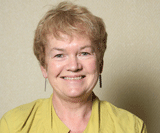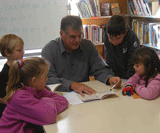Top of the South Island (archived)
This 'slice of action' comes from the Canterbury, Nelson, Marlborough and West Coast region. In these stories the importance of taking time to think about the intent of the curriculum and of including student voice are compelling themes.
Interview with Marg Lees, School Support Services - Education Plus
Marg states the most important indicator for successful implementation will be success for kids. It is important to understand students - what they bring to school, their interests and cultural background, what they think success is and what their fears might be.
'We want to see those disengaged kids engaged.'
This means that students’ voices need to be heard.
'It’s all about the relationship teachers have in the classroom with kids.'
Marg Lees is part of a team supporting the sector leaders in the Canterbury region. This is a geographically diverse region with eighteen clusters spread from north of the Waitaki River.
Marg explains the region is in a 'thinking phase', a time for sector leaders to gain a real understanding of the intent of the document. Paraphrasing from the draft Kiwi Leadership for Principals document, Marg continues,“Principals have to participate in professional learning and be recognised as leading learners in their school. This dimension of pedagogical leadership has the greatest outcome for student achievement… Sector leaders need to know their stuff so they can help other principals and curriculum leaders...”
She explains that it is important for leaders to take time to understand the curriculum before they apply it. 'If you race ahead, you don’t always make decisions based on clear understanding.'
There are a number of innovative projects underway in the region. The South Canterbury cluster has developed a project called 'Our South Canterbury Kids'. They are planning an event where the local council, businesses and interested community groups can showcase how they might support the students in South Canterbury. At the same time the students will showcase ways they can participate in their local communities. This project will allow schools to strengthen connections with their community. It also encourages businesses and the community to think about how they can support students in their areas.
A Canterbury and North Otago rural schools cluster is organising a bus trip to visit other small rural schools so they can investigate different models. The dialogue that continues throughout the journey enhances the value of this experience.
A group within a cluster of Christchurch secondary schools are investigating implementation of the curriculum, then sharing their findings with the wider cluster. The schools are collaborating and learning from each other.
In the wider cluster setting, Marg explains that she sees success as schools working together and engaging in dialogue. Through talking and listening to each other and sharing good practice, the sector leader project schools can help build the frameworks that enable innovation.
UC Education Plus have a wealth of resources on their website to assist sector leaders and schools in the implementation process.
Interview with John Garner, Sector Leader, Top of the South Island cluster (TOSI)
The Top of the South Island cluster is made up of seven small area schools spread widely geographically. Area schools span all levels, placing them in a unique position to explore the curriculum in its entirety. John Garner is the principal of Collingwood Area School, which has around 120 students and is the fourth largest of the schools in the cluster. These schools have worked together as a group for many years now, so formed a natural cluster for the 100 sector leader project.
In November 2007, the TOSI cluster principals met with their school support services provider and came up with an implementation plan for the group. They decided that the first place to start was to ensure all of the principals had a clear understanding of the New Zealand Curriculum and the implications for their schools. Each principal focused on an area of the curriculum. They then went back to their schools and gathered detailed feedback to present to the rest of the group when they met again.
John explained that their next step is to identify a teacher in each of the schools to lead the implementation process. A proposal has been put forward to employ a co-ordinator across the seven schools. The co-ordinator will help share the expertise and knowledge happening in each school across the cluster.
John says the cluster enjoys a good relationship with their UC Education Plus school support services adviser. This relationship helps them keep abreast of curriculum implementation ideas occurring in other schools. They also take advantage of the many resources coming out of the Ministry of Education as well as the Curriculum Online website.
John outlined one indicator for success in this cluster would be that all the schools worked together effectively.
By working together we will be able to do something more than if we were just working on our own.
He cautions that there is a danger for people to do the absolute minimum with the New Zealand Curriculum, to 'window dress' rather than explore the necessary changes to take full advantage of what the new curriculum offers.
For me the new curriculum has huge potential to make some exciting innovations to improve learning in our schools.
The next time this cluster comes together they will discuss where they are at now and future directions. Working together as a cluster is seen as a valuable resource as the schools learn from each other. Area schools have their own specific qualities, so it is important for them to have input from others facing similar issues and challenges.
Interview with Jude Wade, classroom teacher, Christchurch
For Jude, successful implementation will mean motivated students who are reflective and forward thinkers; students who are concerned and aware of their environment and others around them; students who are able to think and process information. They will ask 'so what' questions about their learning and make a difference to their world.
Jude Wade teaches at Cobham Intermediate School where curriculum leaders are working collectively with Canterbury AIMS (Association of Intermediate and Middle Schools) as they implement the New Zealand Curriculum. Representatives of each school work together, then take their findings to their own schools to develop a shared vision and understanding of the intent of the New Zealand Curriculum. Cobham Intermediate teachers are also working with experts to explore what is important for Cobham students to learn.
Jude explains the New Zealand Curriculum formalises many of the inquiry learning practices already in place in her classroom.
We at Cobham are aiming to create an environment where students are motivated and have ownership. Where possible, the kids have more say in what they do and how they do it. It is directed from them and what they think is important to be learning and understanding.
This approach enhances motivation as the students feel passionate about what they learn.
Jude says that the New Zealand Curriculum encourages teachers to design learning programmes with students in mind. She hopes students will be more aware of how they learn, what they learn and why it is relevant to them. Students will be able to apply their learning to different settings and make a difference in their world.
Jude is embracing the intent of the curriculum in her inquiry class. The students take control and design their own learning programmes with support and guidance. Students choose their interests and look for connections with the learning areas and key competencies within the New Zealand Curriculum. The students then design a learning plan and conference with the teacher before embarking on their learning.
We have an environment where the students are motivated learners. They are passionate about what they’re doing, learning how to deal with situations, learning how to solve issues, learning how their brain works, what effects them as a learner, learning the process of inquiry. No matter what they set out to learn they have the process and skills to be able to learn it.


